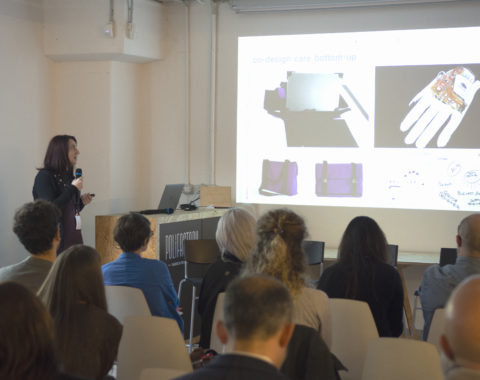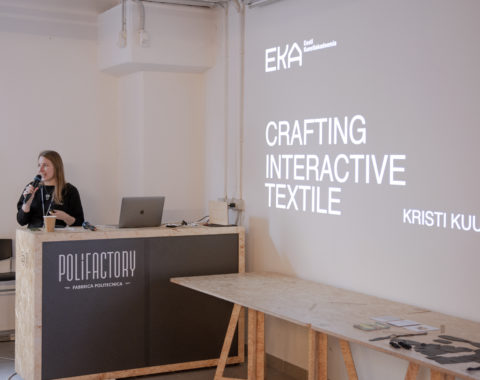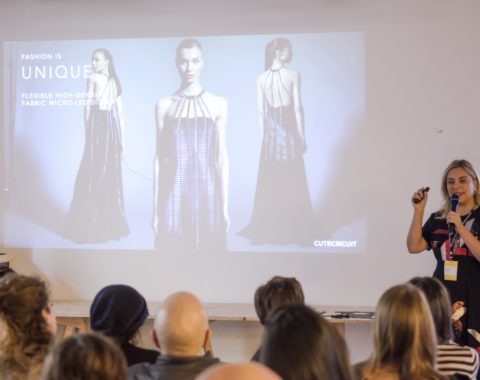Kristi Kuusk is a designer-researcher working on the direction of crafting sustainable smart textile services. She is looking for new ways for textiles and fashion to be more sustainable through the implementation of technology. In 2016 Kristi presented her PhD project on craft and sustainability qualities in smart textile services at the Eindhoven University of Technology in Designing Quality in Interaction research group. Her PhD work related to Augmented Reality on textiles was granted a patent in 2018 and commercialised by an industrial partner. Today Kristi works as an Associate Professor and researcher in the textile futures direction at the Estonian Academy of Arts. In 2017 her project “Magic Lining” was awarded by the jury of VERTIGO to collaborate with ICT R&D projects with the goal of producing original artworks featuring innovative use-cases of the developed technologies. In 2018 her explorative children clothing brand Spellbound was selected by the jury of WORTH as one of the winning projects for transnational creative collaboration. In 2019 Brooklyn fashion + Design Accelerator nominated Kristi as one of the 23 women leading the world of fashion technology.
From your personal experiences, what are the challenges for the Fashion-Tech sector today?
The challenges for Fashion-Tech at the moment are mainly finding the appropriate location in the market and the what use fashion-tech has for people. It’s combining together several ‘traditional’ directions which have their own place in the society, in the environment and in shopping centres. But Fashion-Tech is adding a new category to this traditional combination, and we’re yet to figure out where it should be placed and how people can relate to them. I think this is an opportunity for communication.
What is the future of Fashion-tech, according to your experience? What are you hoping to design in the Fashion-Tech sector in the upcoming years?
At the moment I am working on a project Sensorial fashion aka Magic Lining, alongside scientists, where we are exploring the possibilities of making people feel different about themselves simply by something that they are wearing. It’s not about external looks, it’s about how people feel internally, and we are enhancing those sensations by having vibrations going around the body and creating sensations as if, for example, being lighter, being heavier, being a cloud, being water flow. We are then trying to understand how this then helps the paradigm of fashion to change from being very external and outwards into something more about feelings and wellbeing for people themselves.
What is the expertise in your team and how do your collaborative efforts help you to realise your Fashion-Tech ideas?
I think collaboration becomes an essential part of going forward in Fashion-Tech. There is no way of doing something alone, it is necessary to have a team, it is necessary to have trust and openness between the members of the team. So, team effort, team credit, team everything. And I think it’s, in a way, opening up the way we design, and bringing in all those elements of expertises, which I think it’s impossible to have in one person. So the benefit of having a team and a multidisciplinary team with multi-disciplinary people in it I think is essential.
At what point during the project does collaboration start?
I think it can depend. It is possible to start from an idea and then attract potential partners to the project to go forward together, to have a language to talk to these partners and somehow attract them with the quality of the work. Or it can also start from a collaborative project, like for example within this framework (the DeFINE Network) you’re bringing people together, maybe they are in a nice group and from finding each other they might come up with ideas and concepts to develop from. So I think it can be both ways, and that’s the beauty of it.
How does does the Fashion-Tech design process modify your business model and/or activity?
I think the tech in fashion brings in the service element very clearly. Hybrid parts can be updated, they start to have elements that will be downloaded to them and they have things that can be exchanged and shared as in comparation to traditional textile items, garments, so in that sense I think it changes quite a bit. Specifically when moving from individual products into an actual system where all the elements are interacting with each other and they provide the benefit the project, as a system not as an individual object.
How is COVID-19 changing the Fashion-Tech Sector?
I am sure it provides an opportunistic angle to future development. It has shown us another way of living. Hopefully, we can build on the experience and make sure the future developments build on sustainable and ethical grounds.
What new challenges and opportunities has Covid-19 uncovered in the Fashion-Tech sector?
As each region faces its own challenges, I hope the local Fashion-Tech initiatives can contribute in ways accessible in their particular condition. A great example would be The Fashion Filter by By-wire.net and https://www.labeledby.com/ who very skilfully adapted their material knowledge into producing fashionable masks to promote its streetwear in Europe.




